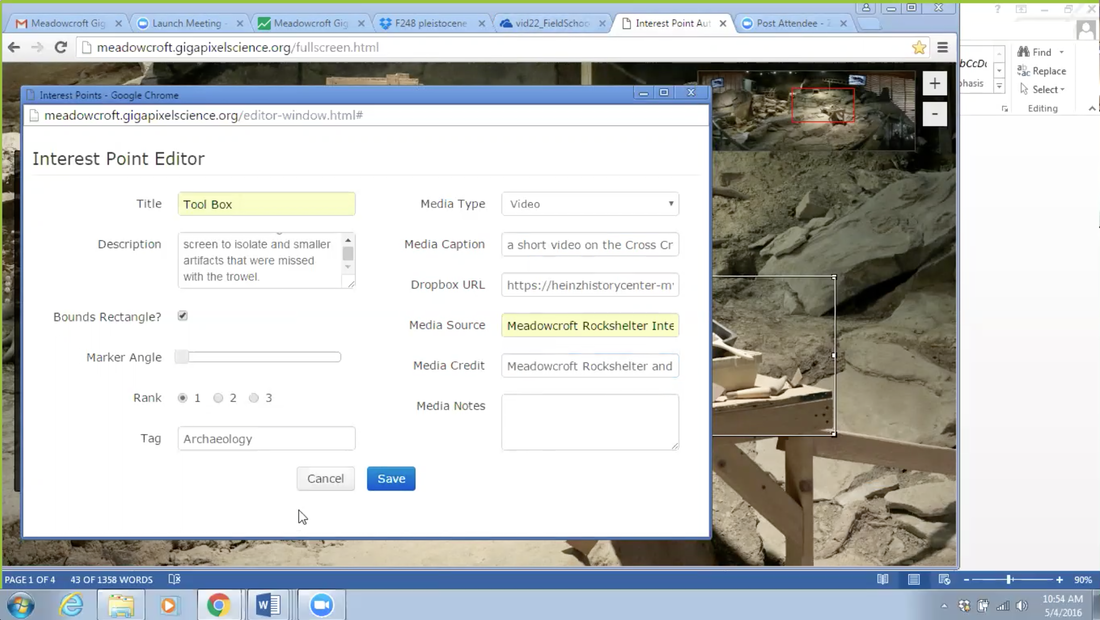|
By Jen Liu The Diagnostic Charactier (DC) annotation tool we are developing for the Macroinvertebrates.org project builds off of the original Interest Point (IP) annotation tool which was developed for museum curators to create, edit and manage the multimedia content overlays associated with interest points placed at set zoom levels in a high-resolution, multiscalar image (e.g. CMNH/Stories in the Rock, Museum of the White Mountains/Beyond Granite).With funding from the Benedum Foundation, Meadowcroft Rockshelter & Historic Village is currently using the IP Tool to annotate gigapixel exhibit images of their archaeological site in Western Pennsylvania that contains evidence of the earliest human presence in North America for online learning. Study Purpose To get a better sense of the disciplinary content management, curation and annotation requirements of different subject matters, we conducted a semi-structured task analysis with Andrew Donovan, the Program Coordinator at Meadowcroft via a video call. He is currently using the tool to annotate Gigapan images of the site to be used as an educational tool for teachers to use with students before and after visiting the Meadowcroft Rock Shelter national historic site.  Screenshot of Andrew's desktop with opened windows necessary for annotations. Screenshot of Andrew's desktop with opened windows necessary for annotations. Annotation Task Analysis During the video call, Andrew shared his screen and followed a "think aloud" instruction explaining his workflow as we observed him completing tasks. In setting up his computer desktop for the image annotation, he would have one Internet browser window open with three tabs for the Microsoft 365, DropBox, and the IP Tool along with a second browser window open for the IP Tool editor. A Microsoft Word file was also opened that contained a table of text copy for the annotations drawn primarily from the website’s Visitors' FAQ section. Originally the annotation source media (e.g. artifact .jpg images) were stored on DropBox, though Meadowcroft is starting to use Microsoft 365 to manage the media content for upload to the annotation overlays. To create and edit new multimedia annotation, Andrew would toggle between multiple windows on a small laptop screen in order to get the information entered and media uploaded into the IP Tool. In watching him navigate these many windows, one thought was to consider how a backend tool could be created to minimize the amount of windows management needed so that information and functionality can be readily present when needed. Another thought was to create a training manual or “best practices” in working with the IP Tool with suggestions for how to efficiently organize the workspace and sequence the annotation data entry process. This could include suggestions for how to arrange the desktop, and make recommendations based on monitor size and dual monitors availability, as well as provide HTML hints to control the font styling (e.g. bolding or italicizing) displayed. The main difference between the way the IP Tool is used by Meadowcroft in comparision to the CMS needs of the Macroinvertebrates.org site is how the interest point display icons and tagging system is being used. In the Meadowcroft IP Tool, the marker angle tool and taxonomic level ranking system is not needed.. The use of marker pin placement and angle tool seems to be a matter of preference by the user, but would be affected by the scale and type of subject matter depicted in the Gigapan image. The Macroinvertebrates.org project focuses on macrophotography of small stream insects, while the Meadowcroft subject matter is panoramic 180° views of an archaeological site. As for the tagging system, the feature is currently being used in the Meadowcroft IP tool for sorting and labeling interest points into different lesson plans for educators, while it is not used for the Macroinvertebrates tool. Of note, in each use cases there is one main person responsible for inputting the bulk of the annotation information. Because of their other job responsibilities, these users tend to have set amounts of free time to enter in text and media, and in Andrew’s case, this tends to be anywhere from half-an-hour to an hour during Meadowcroft’s busy Spring field trip season. This aspect is important to note in terms of designing workflow for users with limited time who need the ability to track and return to where they are in the data entry process. Observing the Meadowcroft use case is a useful comparison and reminder that this backend tool may be utilized for various content, subject matters and contexts in the future. Design Insights:
Comments are closed.
|
Project TeamAn interdisciplinary team Categories
All
Archives
June 2023
|

 RSS Feed
RSS Feed
